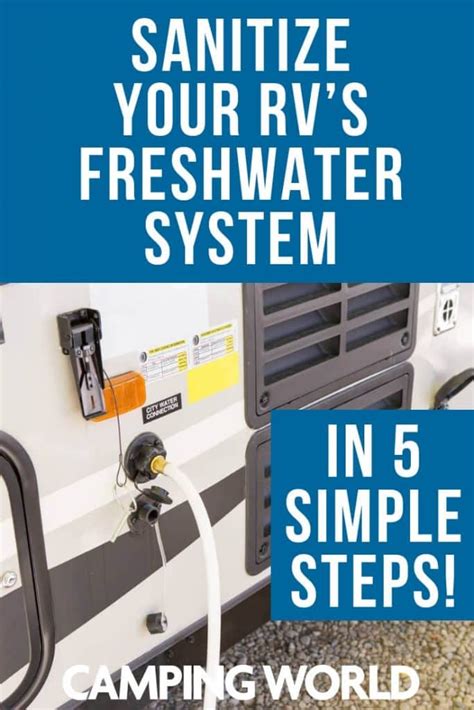RV Fresh Water Tank Maintenance: Sanitizing for Beginners
Maintaining your RV's fresh water tank is crucial for ensuring safe and enjoyable travels. A clean tank prevents the growth of harmful bacteria and ensures your drinking water tastes its best. This guide provides a step-by-step approach to sanitizing your RV's fresh water tank, even for complete beginners. We'll cover everything from the necessary supplies to post-sanitization flushing, answering common questions along the way.
Why is RV Fresh Water Tank Sanitization Important?
Ignoring your fresh water tank can lead to several problems. Stagnant water is a breeding ground for bacteria like E. coli and Legionella, which can cause serious illness. Additionally, biofilm – a slimy layer of bacteria and other microorganisms – can accumulate, impacting the taste and smell of your water. Regular sanitization prevents these issues and keeps your water safe and palatable.
What Supplies Do I Need to Sanitize My RV Fresh Water Tank?
You'll need a few simple supplies for this process:
- Household bleach: This is the most common and effective sanitizer for RV water tanks. Use unscented, regular household bleach.
- Measuring cups: Accurate measurement is crucial for effective sanitization.
- Water hose: To fill and flush the tank.
- RV water tank flush connection: Many RVs have a dedicated port for flushing the tank.
- Gloves: Protect your hands from the bleach.
- Safety glasses: Protect your eyes from splashes.
How Do I Sanitize My RV Fresh Water Tank? A Step-by-Step Guide
-
Empty the Tank: Completely drain your fresh water tank through the low-point drains. If you have a water pump, ensure it's turned off.
-
Rinse the Tank: Flush the tank with clean water to remove any loose sediment or debris.
-
Prepare the Bleach Solution: Mix the bleach solution according to the manufacturer's instructions. Generally, this is about 1/4 cup to 1/2 cup of bleach per 10 gallons of tank capacity. It's always best to err on the side of caution and follow the recommendations on your bleach bottle.
-
Fill the Tank: Fill the tank with clean water and add the prepared bleach solution.
-
Agitate the Tank: Let the bleach solution sit for at least 6-8 hours, or even overnight for a more thorough sanitation. Some RVers gently rock their RV back and forth during this time to help agitate the solution, ensuring better contact with the tank walls.
-
Drain and Flush Thoroughly: Drain the bleach solution completely. Then, refill the tank with fresh water and drain it again. Repeat this process at least three times, or until you no longer smell bleach.
-
Final Flush and Test: After the final flush, run all your faucets and shower until you notice the water is completely clear and free from the bleach smell. You can use a water testing kit to ensure the bleach levels are safe.
How Often Should I Sanitize My RV Fresh Water Tank?
The frequency depends on several factors, including how often you use your RV and the climate in which you store it. As a general rule, it's recommended to sanitize your tank at least twice a year, or more often if you notice any off-putting smells or tastes in your water. Before each camping season is a good time to undertake this essential maintenance.
What are Some Common Mistakes to Avoid When Sanitizing My RV Fresh Water Tank?
- Using too little bleach: Insufficient bleach will not effectively kill bacteria.
- Not flushing thoroughly: Residual bleach can cause problems with taste and potentially damage your RV system.
- Ignoring the smell/taste: If you still smell or taste bleach, flush the tank again.
- Using other sanitizing agents: While some alternatives exist, bleach is generally considered the most effective and readily available option. Always follow the manufacturer's guidelines for any sanitizer.
Can I use something other than bleach to sanitize my RV fresh water tank?
While bleach is the most common and effective method, some RVers explore alternative sanitizing agents like RV specific water tank sanitizers. These products often utilize different chemical formulations designed for the same purpose. However, always carefully follow the manufacturer's instructions for any alternative sanitizer.
What if I notice a persistent bad smell or taste even after sanitizing?
A persistent unpleasant smell or taste could indicate a more serious problem, such as a buildup of algae or sediment in the tank, or possibly a leak that is contaminating the water. If the problem persists after multiple sanitization attempts, you may need a professional inspection of your RV's water system.
By following these steps and addressing common concerns, you can confidently maintain a clean and safe fresh water tank in your RV, ensuring worry-free enjoyment of your travels. Remember, regular maintenance is key to preventing problems and protecting your health.

